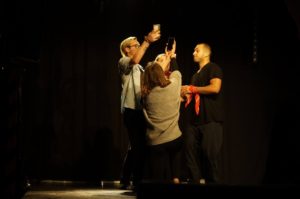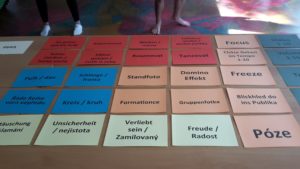
“Wie, Sie … äh… du weißt nicht wie Snapchat geht?” Three pairs of eyes fix me in complete disbelief. A part of me wants the floor of the rehearsal room to open wide and swallow me there and then. For the third time in less than two hours I am pleading age-related ignorance of this or that social media platform. And it is only day 1 of the workshop.
Catching up with 21st-century culture was an interesting by-product of my work with Čojč Theaternetzwerk Böhmen Bayern (http://cojc.eu/cs/), a Czech-German theatre network in 2017. The network organises bilingual theatre projects on both sides of the border, and I joined last year’s main project, Like/Hate, as a participant observer. For two weeks in August and September, Like/Hate brought together 20 young people aged 14 to 27 living Bavaria and Bohemia to create a theatrical performance centering on the influence of social networks on our thinking, behaviour, and the way we present ourselves to the world. My main reason for observing the project had less to do with the question how we conceive of performing the self in and through social media than with an interest in the participants’ real-life communication and interactions – with each other and with the audience.
In many bilingual youth projects along the German borders, pooling linguistic resources is considered one of the main strategies for facilitating intercultural dialogue and fostering cross-border relationships unencumbered (or at least less encumbered) by the baggage of historical differences between the Germans and their neighbours. Čojč projects are no exception but they go one step further in that they aim to create performances which are accessible to monolingual speakers of Czech and German alike by using a hybrid of Czech and German, Čojč, on stage. The network motto provides a good example of how this can work: ‘Mit divadlem theater hýbat grenzen hranicemi bewegen’. The word Čojč itself is a blend of from the Czech word for the Czech language, Česky, and the use of Czech spelling for the word [d]eutsch – [d]ojč, and in some senses, Čojč (the language) is the verbal manifestation of a strong sense of a distinct regional identity grounded in the historical and cultural particularities of the Bavarian-Bohemian border region that pervades the network.
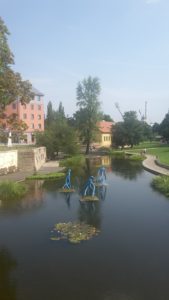
The city of Plzeň
So how does the Čojč network use language(s) to express, negotiate and potentially transform (individual) identities? How do workshop participants communicate with each other? Which language do they use, when, and why? What are the effects of using a hybrid language on the audience? In other words, how is regional identity performed and how is it changed in and through performance? And how do such performances integrate into contemporary discourses about the role of regions in responding to societal challenges within the EU? These were just some the questions that guided my observation of the devising process and the interviews I conducted with participants and network members. The larger framework for this research is the Horizon2020-funded project Critical Heritages: performing and representing identities in Europe (CoHERE) (https://research.ncl.ac.uk/cohere/) which investigates the socio-political and cultural significance of European heritages and their role in developing communitarian identities. My work with Čojč Theaternetzwerk Böhmen Bayern forms a case study within the project work package led by Heriot-Watt and the Latvian Academy of Culture focusing on cultural forms and expressions of identity in Europe (PI: Prof Ullrich Kockel).
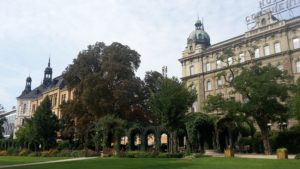
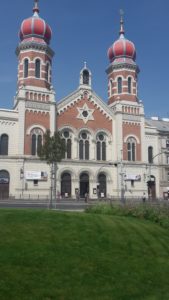
Landmarks of Plzeň
Data analysis is still ongoing, but some main themes are already emerging. The first is the importance of liminal spaces in which borders – linguistic, cultural, political – and dichotomies are temporarily suspended a and in which the question of the contours of a particular cross-border identity can be explored and negotiated. The second concerns language use. For Like/Hate, some ground rules for communication were assigned top-down from the bilingual project leader team; more frequently, however, participants made their own decisions about how to communicate effectively with each other and how to produce theatrical material that is accessible to monolingual speakers of Czech and German respectively. Bilingual cooperation relied quite strongly on translation in the devising and rehearsal process. Within that process, translation was conceived of from the outset as a collaborative activity – and a collaborative responsibility. While translation accountability was sometimes regarded as an unwanted or uncomfortable responsibility by the participants, it also holds the potential to become a vehicle for authority in the co-creative process. Moreover, the communication choices made by the participants clearly went beyond pragmatic concerns: they frequently reflected existing linguistic asymmetries. Or, in other words, German dominated the rehearsal room. These initial findings about communication choices suggest interesting parallels with other bilingual theatre workshops, such as Michael Richardson’s (Heriot-Watt University) investigations into BSL-English theatre. These will be presented as part of a comparative study at the upcoming conference of the International Association for Translation and Intercultural Studies (IATIS) in Hong Kong:
Pfeiffer, K., and Wurm, S., ‘(Un)Performing Barriers: A comparative study of bilingual theatre in two inter-cultural spaces’, paper to be presented at 6th IATIS Conference, 3-6 July 2018, Hong Kong
Curious about Čojč and Like/Hate? Meet the participants and watch the project vlogs here: https://www.like-hate.com. Two of seven performances in Passau and Pilsen are also available as a livestream on the Čojč Land Network Facebook page https://www.facebook.com/cojcface/.
